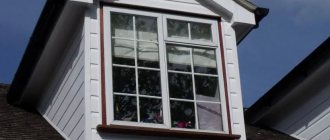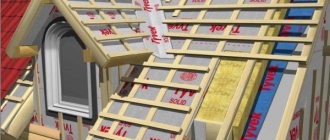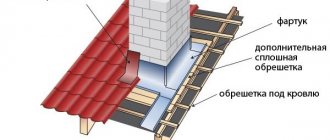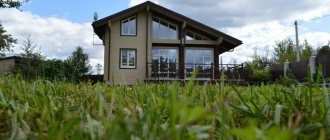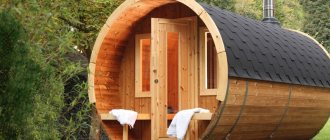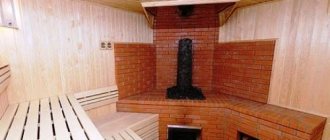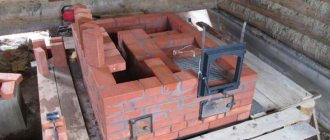One of the final stages of the construction of any building is the installation of drainage from the roof. It serves to prevent walls from getting wet, foundations and blind areas from being washed away by storm and melt water flowing from the roof.
High humidity provokes the development of mold. Water flowing onto the ground can flood basements or ground floors, leading to the destruction of foundations and uneven settlement of the building.
Modern drainage systems fit harmoniously into any style of home and can become part of the decorative design of the facade.
Figure 1. Pitched roof drainage.
Drainage system: purpose and composition
In houses with pitched roofs, the drainage system is installed outside the building. It consists of the following components:
- gutters;
- pipes;
- knee;
- funnels;
- hook-brackets;
- seals;
- connecting elements.
Manufacturers of drainage systems use various materials that differ in both wear resistance and price. The most popular are:
- galvanized modular systems with and without coating;
- plastic, made of pvc;
- classic aluminum;
- increased reliability titanium-zinc;
- elite copper.
When choosing a material, you need to take into account the purpose of the house and financial capabilities. If plastic is ideal for a budget option, then for a country residence - a copper drain. Such a design will not only serve for decades without repair - which also applies to options made of titanium-zinc and aluminum - but will also create a feeling of luxury and indicate the high status of the owner.
Metal gutters are much more durable and will last longer Source remontik.org
Let's sum it up
A rooftop storm drain is a system that carries rainfall to a drain or sewer rather than dumping it on the sidewalk. It is needed so that water does not erode the foundation, wet the walls and turn into icicles on the eaves.
Storm drains can be open or internal.
An open storm drain is cheap, reliable, and easy to install. But it has limited capacity and cannot be used on tall buildings.
Internal drainage is effective and suitable for any building, but due to the high cost and complexity of installation, it is not used in private houses, despite all the advantages.
When to install roof drainage
Depending on the type of drain, it is installed either before laying the roof covering of the house, or after this work has been carried out.
The metal system, mounted to the bottom deck board or to the rafters, is attached to long hooks before roofing work begins.
Professional builders use this method with large areas of slopes and/or with significant throughput of the installed system.
If the roofing work has already been completed, then the best option would be a plastic system, the hooks for which can be attached at any stage.
This method is also optimal for large slope areas and high system throughput.
Hooks for the plastic system can be attached to the front board after laying the covering.
As a rule, storm drainage systems from the roof, their type and material, are determined at the design stage of the house. In this case, the customer can make adjustments until the roofing work begins.
Storm drains rest on special hooks Source atdomnsk.ru
See also: Contacts of construction companies that offer turnkey design and installation services for water supply, sewerage and drainage systems.
What are the types of usable flat roofs?
- Green (often called environmental);
- Roof terraces with seating areas;
- Parking lots (extremely rare in Russia).
Let us consider in detail the most common of them.
Green or eco-roofs
Drainage for a green roof is designed to drain the soil layer and prevent the destruction of roofing and waterproofing layers under the plants. Eco-roofs are very popular because they make big cities greener, cozier and healthier. In addition, the accumulation of stormwater in plants and soil reduces the peak load on the sewer system - unless the rain loads are so great that the plants and soil can no longer absorb the liquids. In the absence of a controlled moisture retention system, excess moisture will easily flow into the public sewer system.
Extensive landscaping is achieved with easy-to-maintain low-growing groundcovers such as grasses, moss, flowers and various types of sedum. Intensive landscaping involves a greater variety of plants: perennials, shrubs, flowers, sometimes even small trees. The only limiting factor is the stability of the roof structure: with a load-bearing capacity of up to 150 kg/m2, as a rule, only extensive landscaping can be supported, but with a load-bearing capacity of up to 500 kg/m2, intensive landscaping can be done.
Stormwater system where to start
At the design stage, it is important to make the correct calculations. Typically, this work is carried out by a house construction company. The following parameters are taken into account in the calculations:
- The slope of the roof of the building.
- Number of drainage and water intake points.
- Location of water intake and drainage points.
All this depends on the territory, the layout of the house, the type of structures and materials from which the modular system is made.
At the stage of installing roof drainage, it is necessary to maintain the slope of the gutters. As practice shows, the optimal slope per 1 meter of a gutter should be from 2 to 5 millimeters. If these parameters are observed, storm water will not stagnate in the system or overflow. Properly organized drainage is a guarantee that the system can cope even with large amounts of precipitation, which is important for most regions of our country.
When installing a storm drain, it is important to maintain the angle of inclination so that water does not stagnate in the pipes during operation Source dvamolotka.ru
The assembly of gutters is carried out in various ways and depends on the configuration of the system. The most common option is butt assembly using seals, which include rubber gaskets, staples, and special ties. In some cases, silicone sealant or adhesive joints are used.
Attention! The number of holders and clamps in systems may vary. Based on this, it is better to entrust the purchase of such material to professionals who are familiar with the features of products from various manufacturers.
Features of installing gutters
The drainage system must be installed according to certain rules and taking into account certain features:
When installing a drainage system yourself, it is important to maintain a distance of at least 5 cm between the wall and the drain pipe. Otherwise, the wall will be in constant contact with the wet pipe. The drainage system, especially gutters, must be installed with a certain slope towards the funnels
Thanks to this design, water will flow freely down the gutter without accumulating or overflowing over the edges of the gutter. Installing a hidden drain on a pitched roof involves installing the system behind the facing layer or hanging panels. The joints and fastenings must be sealed. For this purpose, special glue, cold welding and rubber seals are used.
When choosing one or another sealing option, you should study the advantages and disadvantages of each of them:
- Rubber elements are resistant to mechanical stress and seal the drainage system well. But it is worth considering their sensitivity to high and low temperatures, and for their normal functioning an average temperature is required.
- The connection with glue is also reliable and airtight, but dismantling such a system is impossible.
- Cold welding is the most reliable and hermetically sealed connection, but changing the linear dimensions of the system elements leads to cracking of the joints.
Consequently, the method of joining drainage elements is selected based on certain operating conditions.
How to choose the right material for a roof drain
Roof drains made of galvanized steel, treated with a polymer coating, are durable, reliable and highly wear-resistant. They are used “in a set” with roofs made of metal tiles and corrugated sheets. Such systems are quickly installed, which reduces the overall cost of the building.
Drainage system made of galvanized steel with polymer coating Source siding-ps.ru
A metal system with double protection – polymer and zinc – prevents corrosion and withstands significant mechanical loads. One of the main advantages is linear expansion depending on temperature fluctuations. A drain made of metal does not require elements that compensate for linear expansion. It is worth noting that in the northern regions, such modules have proven themselves due to their ability to withstand snow loads, and in the southern regions – due to their resistance to ultraviolet radiation.
A budget PVC system will also do the job perfectly. Due to the composition of the plastic, such modules are practically inert to the negative influence of the environment. Among the main advantages are:
- speed and ease of installation;
- a light weight;
- restoration of the original shape after mechanical impact;
- corrosion resistance
- absence of noise effects even during heavy precipitation;
- wide range of colors.
In addition, manufacturers produce non-standard elements that allow aesthetic installation in houses with bay windows.
PVC drainage systems are cheaper, but they do their job perfectly Source tk-stroyresurs.ru
From metal profiles for plasterboard
The lightweight and durable metal profile is perfect for draining water. We find the required amount of material based on the perimeter of the roof of the house.
Profiles around the entire perimeter of the house can be attached to:
To protect against water pouring out of the gutters, it is cut into 2 parts, the end is left above the funnel and bent to make a semicircle barrier at the corner. The drain pipes and funnel will have to be made from other materials.
How to install a drain
Installation of any type of drain requires not only certain skills, but also a fairly extensive material and technical base. In addition, in addition to the design itself, additional consumables such as anti-corrosion fasteners will be needed.
Drainage from the roof is installed from top to bottom and occurs according to a strictly defined plan:
Gutter installation:
- Gutters intended for drainage are fixed. They are placed below the level of the roof slope, and have a slope towards the funnel - an approximate interval of 3 centimeters - every 10 meters. To do this, markings are applied indicating the exact mounting points of the brackets.
- at the lower mark , and a bracket at the upper mark.
- between these first elements of the system .
- According to the existing level, other brackets and couplings are attached.
- The distance between the brackets and the funnel is 10 cm.
- After completing the installation of the brackets, the gutter itself is fixed to them.
- The joints between the gutters are fixed using a coupling.
Sectional diagram of drainage installation Source heatylab.com
- The internal and external corners, designed to connect the gutter at the corners of the house, are secured and closed with special plugs.
Installation of the drainage system:
- The pipe must be firmly secured in the upper part, for which special clamps are used.
- In the lower part, the fastening is carried out with the so-called slipping.
- An elbow is attached to the funnel with a second elbow already attached to it, the orientation of which is directed in the opposite direction.
- The drain pipe is drawn as close as possible to the wall of the house.
- The second elbow is attached to the wall using a clamp.
- The drain elbow is fixed at a distance of 30 cm from the soil surface.
All elements of the drainage system must be installed strictly vertically, for which special construction tools are used.
Drainage drains are carried to the septic tank, where all wastewater is drained Source domikarkas.ru
Forms of designs
The easiest way to make a gutter with your own hands is from painted or galvanized metal sheets. You can give it a rectangular or semicircular shape.
You can make a semicircular shape using a rolling tool by cutting a piece of galvanized pipe. First you need to cut the metal sheet to the required size. To impart sufficient rigidity and strength to the structure, its edges should be bent and connected with strips.
In a similar way, you can make round pipes with your own hands. The edges of the sheet should be folded (folded). Then connect and then bend with a mallet. A rectangular pipe can be made using a bending machine or a simple rail. Professionally made elements of the drainage system look beautiful. You can purchase them and install the water supply system yourself.
The resulting gutters with a slight slope are mounted around the perimeter of the roof and secured. At the junction points of the gutters, connectors cut from steel sheet are used.
Choosing a drainage system: recommendations from experts
As already mentioned, the choice of drainage system is made taking into account the characteristics of your region, the concept of the structure, the cost of work and materials.
Modern manufacturers offer a huge number of system options that can be installed both on buildings under construction and on finished houses.
Most home building owners prefer not to delve into the specifics of arranging a stormwater system, relying on the professionalism of construction company employees. However, it won’t hurt to get acquainted with some nuances:
- Ideally, all elements should be from the same manufacturer. This will ensure reliable installation and no leaks.
- When choosing galvanized systems, keep in mind that the unaesthetic appearance of a wide funnel compensates for errors in the manufacture of parts.
- A roof whose drainage system is made without gutters will not leak due to the reliability of the design. However, you may encounter some difficulties during installation work.
Drainpipes from the roof smoothly turn into sewers hiding underground Source prostroyer.ru
- The service life of galvanized pipes and systems made from them, with proper care, can exceed 25 years.
- Metal systems coated with zinc-polymer material look attractive, are protected from corrosion, do not require special care and last up to 50 years. In addition, it is possible to order individual designs of gutters and choose a color that matches the design of the house.
- Before installing plastic structures in the northern regions, it is necessary to consult with specialists.
Varieties of modern drainage systems by material of manufacture
Traditionally, gutter systems were made of galvanized steel. And today this material has not left the market. They simply began to coat the galvanized drain with paint, thereby matching it to the color of the roofing material, creating a unified design for the house. Plus, it became possible to extend the service life due to an additional protective layer.
Today, manufacturers offer galvanized gutters and polymer coating. In this case, the polymer coating is applied both on the outside of the galvanized sheet and on the inside. This means better protection and a huge variety of colors, unlimited in any way.
Plastic drainage structureSource rooms-styling.com
Plastic gutters are the most popular today. They are made from polyvinyl chloride (PVC). But this material is not used in its pure form, because it itself becomes brittle at low temperatures. Additives are added to it, which increase the strength of the polymer, so PVC gutters are not afraid of temperature changes and sunlight. And the biggest plus is that plastic is the cheapest material.
The modern market today offers drainage systems made of copper or stainless steel.
Copper drainSource pinterest.com
Operating rules
Do not forget that any roof drainage system requires regular maintenance. To avoid blockages, it must be cleared, which can be done either independently or using the services of specialized companies.
If the local area has an underground stormwater system, the best option would be to drain the drain directly into a storm well.
This is what the finished drainage system of a private house looks like Source kanalizacijapro.ru
Make sure your drainage system contains something like a screen to filter out large debris.
Where should the water from the drainpipes be directed next?
The best solution is to connect drainpipes to some kind of closed water collection and drainage system . It could be:
- Underground drainage system to drain the site. The drainpipe is connected to the outlet of the drainage system through a collector well with a check valve that prevents rainwater from entering the drainage pipes;
- Storm drainage system for collecting and draining water from the surface of the site;
- A special system for collecting and storing rain and melt water for the purpose of its further use for irrigation and other household needs.
- Sewage system for household wastewater. With a centralized sewerage system, it is necessary to obtain permission to receive additional volumes of wastewater from the owner of the network (as a rule, permission is granted for an additional fee).
The rainwater inlet of the roof drainage system of a private house is equipped with a debris catcher, which must be regularly cleaned through the hatch.
Drainpipes are connected to the water intake pipes of closed storm sewer systems through special devices - storm water inlets.
These devices collect large debris (leaves, etc.), and they may also have a valve that prevents air (odors) from escaping from the sewer system. The rainwater inlet has a hatch through which you will periodically have to remove the debris that has accumulated there.
Draining rainwater through closed sewer systems significantly increases the cost of building a house.
Products for construction and repair
⇆
Most often, in economy class houses, near-surface drainage trays are used to receive and drain water flowing from a drainpipe .
From the drainpipe, water enters the drainage tray of the blind area of a private house
Such trays are usually installed not only to drain water from the roof, but also to collect and drain surface runoff from blind areas and other hard-surfaced areas. Water can be discharged from the trays onto the terrain of the site in a convenient place away from buildings or into a drainage well.
Drainage trays are usually made locally from concrete or using ready-made drainage systems made of concrete, plastic or metal. Ready-made near-surface drainage systems from different manufacturers are available for sale. The main elements of such systems are trays and removable grids that cover the tray from above.
A drainage device is installed on the drainpipes, which directs rainwater into a container installed nearby, a barrel. The device stops the flow of water into the container if it is completely filled.
A decorative container for collecting and storing water from drainpipes can become a home decoration.
